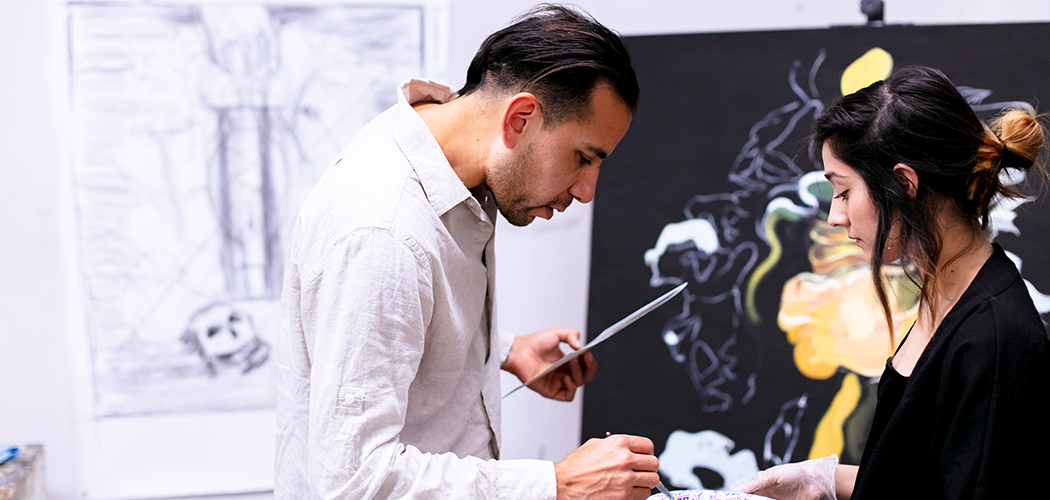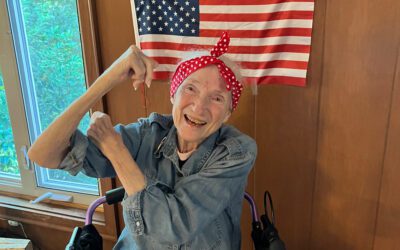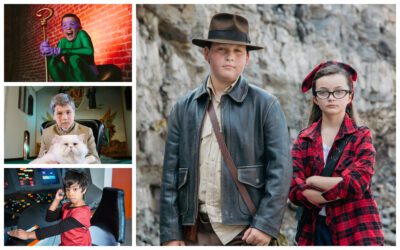[title subtitle=”words: Dwain Hebda
images:courtesy Rachel Rodemann Putman, Grant Thomas, and Fort Smith Symphony”][/title]
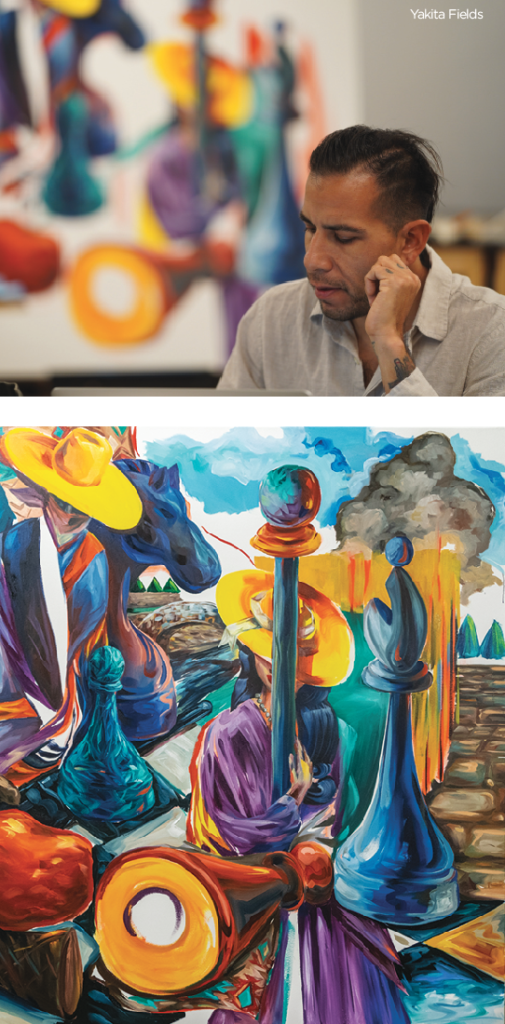 Yakita Starr Fields paints with the intensity of the sudden summer storms over the Oklahoma plains from hence he came. Bold color flashes onto the canvas like lightning splitting the sky; forms and shapes roil and coalesce like July thunderclouds, powerful and fluid. Fields’ Creek name, “Yvtekv,” means Interpreter and so he is, translating color and line into a language all its own.
Yakita Starr Fields paints with the intensity of the sudden summer storms over the Oklahoma plains from hence he came. Bold color flashes onto the canvas like lightning splitting the sky; forms and shapes roil and coalesce like July thunderclouds, powerful and fluid. Fields’ Creek name, “Yvtekv,” means Interpreter and so he is, translating color and line into a language all its own.
“When I make art I don’t do sketches. Usually if I do paintings, I have two colors maybe and I really rely on just the beauty of the brush stroke. I make gestural forms. I’m spontaneous about it, I create compositions quickly on the canvas,” he says. “It’s like a song, almost. A good painting just sounds good. It looks good. You know it when it’s done.”
Yakita’s work is viewed all over the world and first came to Fort Smith in a big way as part of last year’s The Unexpected, the public art and murals entity which is transforming the city’s downtown district one wall at a time. This year, he returned to be part of an ambitious collaboration between The Unexpected and the Fort Smith Symphony which utilized art students from the University of Arkansas-Fort Smith.
“I thought [the project] was pretty cool because my process really relates to instinctual feelings,” he says. “My process is a lot different than any other artist’s and it works well with music, I think. It’s about tuning into intuition and about feeling from the heart and moving like music moves, just as a composer composes his music through intuition and another plane of thinking and feeling.”

The project brings together visual and musical art forms, with each inspiring the other to explore unique forms of expression. John Jeter, Conductor of the Fort Smith Symphony, approached The Unexpected organization with the notion of replicating an 1874 piece by Russian composer Modest Mussorgsky, titled Pictures in an Exhibition.
Mussorgsky was inspired to write the piece – originally for solo piano, later arranged as an orchestral piece – after viewing a retrospective of his late friend and artist, Viktor Hartmann. Mussorgsky’s suite included musical depictions of ten Hartmann paintings, interspersed with a recurring intermezzo, representing a visitor strolling through the exhibition.
John turned the tables on the process by having Yakita and the UA-Fort Smith art students listen to the music and paint what they heard.
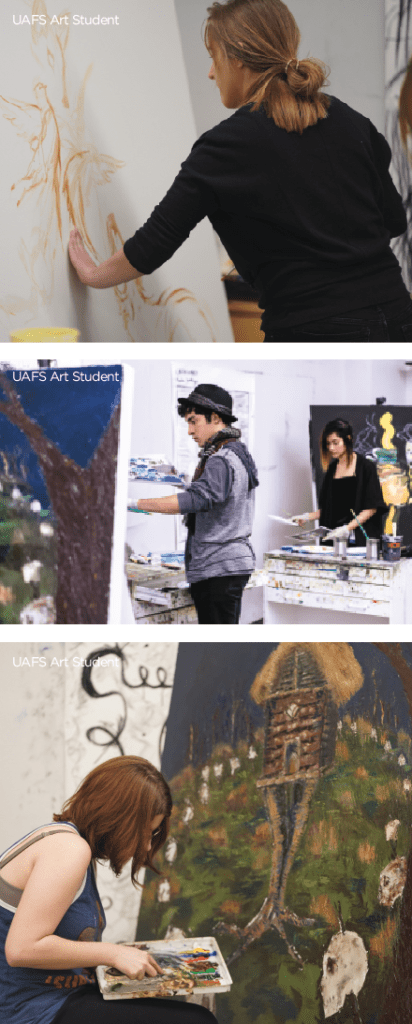 “The students here in Fort Smith are eager to learn,” Yakita says. “There was no curriculum to it. I came in, I set the pace on it and talked about my work and what it looks like and they listened. We really had a good time together, all of us. By the end of it we were laughing, and they didn’t want me to leave.”
“The students here in Fort Smith are eager to learn,” Yakita says. “There was no curriculum to it. I came in, I set the pace on it and talked about my work and what it looks like and they listened. We really had a good time together, all of us. By the end of it we were laughing, and they didn’t want me to leave.”
Jody Barbaree, one of the student artists who participated, considers the experience an artistic awakening. His work, “Cattle Painting, with Cream and Late Evening Blue,” was a tremendous learning experience.
“When I first heard about the project, I was excited because it was a chance for me to have the opportunity to get a huge canvas that was yours, here, you could have it,” he says. “The parameters for the project were basically, whatever vision you have, listen to this piece of music and you can create whatever vision you see. And I loved that, it was a chance for me to show what I could do.
“I’d never painted with oils before and I didn’t even know how to make the colors I wanted. Yakita helped answer some questions about that as well. He was excited about my vision. It was just a fun opportunity.”
The project, which will display (and make available for purchase) the UAFS art students’ paintings at a symphony performance entitled It’s Time for Pictures, in May, is the latest effort by the city to reinvent and revitalize itself. Where other communities leverage professional sports or cycling trails, Fort Smith views a growing arts community as an important page in the city’s next and brightest chapter.
“The symphony has been talking about the importance of the arts for economic development for over two decades,” John says. “I’ve noticed in that time, for small and medium sized communities throughout the country, this idea of let’s have an arts sector, an arts neighborhood, has really become one of the main ideas to bump up a community’s status. You see it happening all over the place.”
In its fifth Arts & Economic Prosperity report, the nonprofit Americans for the Arts showed the financial impact of such community amenities. The organization reported the nation’s nonprofit arts and culture organizations and their audiences generated $166.3 billion of economic activity during 2015. This activity supported 4.6 million jobs and generated $27.5 billion in revenue to local, state, and federal governments, a handsome payback on the collective $5 billion the arts received in public monies.
The report also looked at selected communities and studied regions coast to coast, including the Northwest Arkansas corridor. There, organizations and their audiences spent a combined $131 million, supported nearly 5,000 jobs and generated more than $14.3 million in local and state taxes.
“From coast to coast and from our smallest rural towns to our largest urban cities, America’s 100,000 nonprofit arts and cultural organizations make their communities more desirable places to live and work every day of the year,” wrote the project leads. “The arts provide inspiration and joy to residents, beautify public spaces and strengthen the social fabric of our communities.”
John says the impact of arts is so profound in creating quality of place, it plays a major role in companies choosing to relocate to a community or to keep looking.
“Even for businesses and professionals who maybe don’t even take advantage of [art] as much, knowing that a community has a strong arts component says a lot for the stability and quality of the community,” he says.
“I’ve come across heads of companies who will admit, ‘I’m not a super big arts person, but I absolutely know that a vibrant community has this.’ So, I think there’s been enough proven track record of arts making a huge difference.”
Claire Kolberg, Director of The Unexpected, has seen these concepts at work since the organization produced its first public art in 2015. In the years that followed, both the organization and the community honed a partnership that has become the model for other cities to follow.
“What’s unique about Fort Smith is, we were able to capture art space in a way that didn’t duplicate what existing organizations were already doing,” she says. “The history of Fort Smith is based on rule-breakers, outlaws and innovators, and we want to bring that same character to Fort Smith and The Unexpected, while challenging perceptions on what it means, and meant historically, to live on the western frontier.
“That’s what makes The Unexpected so unique for Fort Smith; it forces us to challenge ourselves to look to other ways to develop economically, especially as a city that once relied on heavy manufacturing. But it also challenges perceptions nationally and globally about what it means to participate in the arts in Arkansas.”
The collaboration is likely not the last between the symphony and The Unexpected and Claire says she hopes these works inspire a wave of other artistic collaboration as well.
“We need to continue to introduce new artists and audiences to each other. That includes musical art, performing arts, visual arts, all the arts,” she says. “As far as I’m concerned, any artform that you introduce to an audience will support and build a vibrant community.”
Fort Smith Symphony
It’s Time for Pictures
Saturday, May 11, 2019 at 7:30pm
ArcBest Performing Arts Center
479.452.7575
fortsmithsymphony.org
The Unexpected
unexpectedfs.com
University of Arkansas Fort Smith – Windgate Art & Design
5210 Kinkead Avenue, Fort Smith, Arkansas
479.788.7530

